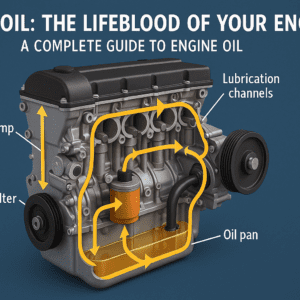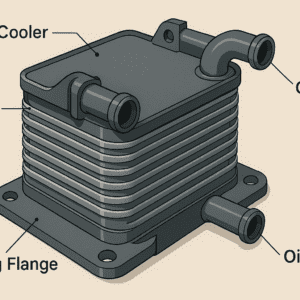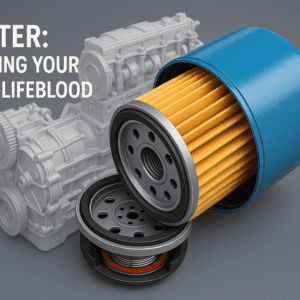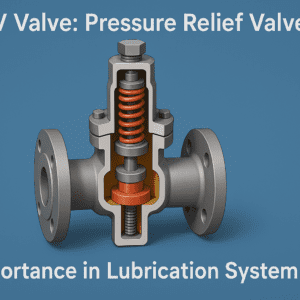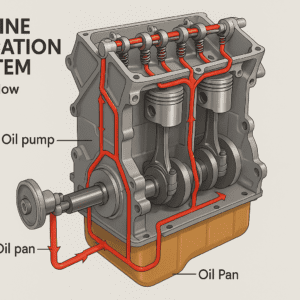
1. Introduction to Oil Pumps
Oil pumps are like the unsung heroes of our vehicles and industrial machinery. They work tirelessly behind the scenes, making sure everything runs smoothly. Think of them as the heart of your engine’s circulatory system, pumping life-giving oil to all the important parts.
Why should you care about oil pumps? Well, they’re crucial for keeping your engine healthy and running at its best. A good oil pump can mean the difference between a car that purrs like a kitten and one that sounds like it’s on its last legs.
To read more about lubrication system click on this link: Lubrication System
2. What is an Oil Pump?
An oil pump is a device that moves oil around your engine. It’s like a tiny but powerful pump that keeps oil flowing where it needs to go. The main job of an oil pump is to make sure all the moving parts in your engine stay well-lubricated.
But that’s not all! Oil pumps also help keep your engine cool. As the oil moves around, it carries heat away from hot spots, kind of like how our blood helps regulate our body temperature.
Your engine is like a busy kitchen, and the oil pump is the chef making sure every ingredient (or part) is perfectly coated and doesn’t stick or burn.
3. Types of Oil Pumps
There are a few different types of oil pumps out there. Let’s take a look at the most common ones:
3.1 Gear-type Oil Pump
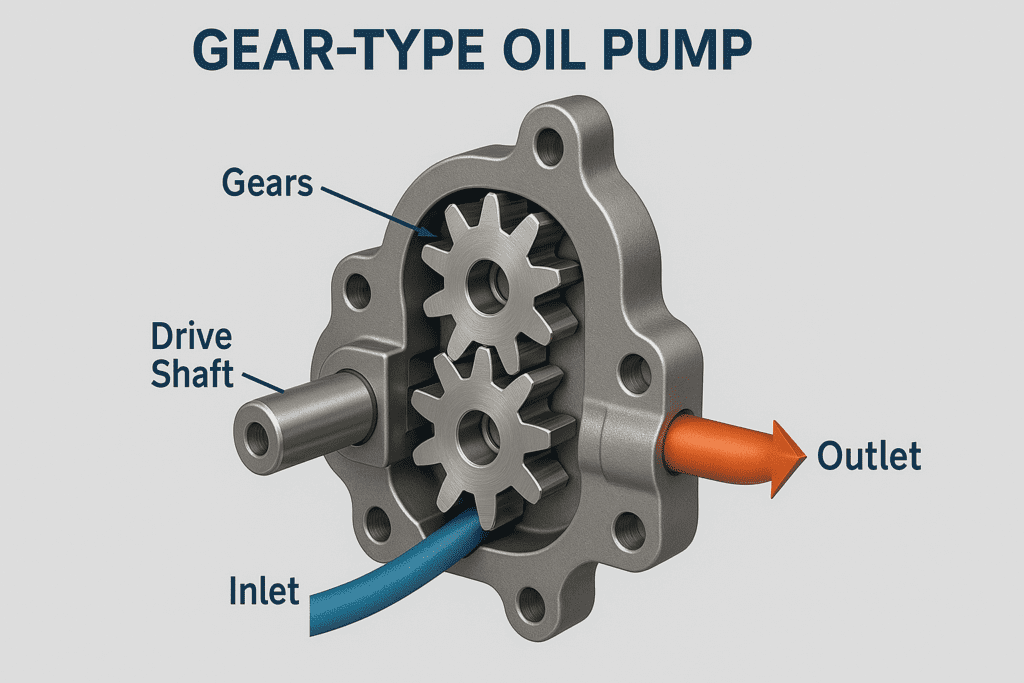
Today, let’s chat about a nifty little device that keeps our engines running smoothly: the gear-type oil pump. This unsung hero of our vehicles plays a crucial role in keeping everything well-oiled and functioning properly.
So, what exactly is a gear-type oil pump? Well, it’s a simple yet effective mechanism that circulates oil throughout the engine. Two gears meshing together inside a housing. As these gears rotate, they create suction that draws oil from the sump and pushes it through the engine’s various parts.
The beauty of gear-type oil pumps lies in their reliability and efficiency. They’re known for their consistent oil flow, which is super important for keeping all those moving parts in your engine happy and healthy. Plus, they’re relatively compact, making them a popular choice in many modern engines.
One cool thing about these pumps is how they adjust to different engine speeds. As your engine revs up, the pump works harder to keep up with the increased demand for oil. It’s like having a little helper that knows exactly when to pick up the pace!
Remember, though, like any part of your car, oil pumps need some TLC too. Regular oil changes and proper maintenance can help keep your gear-type oil pump in tip-top shape for years to come.
- Uses two gears that mesh together to pump oil
- Often found in older or simpler engines
- Reliable and straightforward
To read more about engine click on this link: Engine
3.2 Rotor-type Oil Pump

Your car’s engine as a busy city, and the oil pump as its hardworking delivery service. The rotor-type oil pump is like a super-efficient courier, making sure every part of the engine gets the oil it needs to stay cool and work properly.
3.2.1 How It Works
Two gears nestled inside a metal housing. One gear (the inner rotor) has fewer teeth than the other (the outer rotor). As they spin together, they create little pockets that fill with oil and then squeeze it out under pressure. It’s kind of like when you squeeze a tube of toothpaste!
3.2.2 Why It’s Cool
- It’s reliable: These pumps are tough cookies and can handle the heat and pressure of your engine.
- It’s efficient: They can pump a lot of oil without using too much energy.
- It’s compact: These pumps don’t take up much space, which is great for modern engines that are packed tight.
Fun fact: The rotor-type oil pump is so good at its job that it’s used in many modern cars, from your everyday sedan to high-performance sports cars!
- Has an inner and outer rotor that spin to move oil
- Common in modern engines
- Efficient and can handle higher pressures
3.3 Vane-type Oil Pump

Today, let’s chat about a crucial component in our vehicles: the vane-type oil pump. This little wonder plays a big role in keeping our engines running smoothly.
Imagine a circular chamber with a rotor inside. This rotor has vanes that slide in and out as it spins. As it rotates, these vanes create pockets that grow and shrink, kind of like a heartbeat. This action draws oil in and then pushes it out under pressure.
The cool thing about vane pumps is how efficient they are. They can handle a wide range of oil viscosities and temperatures, which is super important for our engines. Plus, they’re generally quiet and reliable, which we all appreciate, right?
One of the neat features of these pumps is their ability to adjust oil flow based on engine needs. When your engine is working hard, the pump can increase oil flow to keep everything well-lubricated.
- Uses a rotor with vanes that slide in and out
- Less common but still used in some engines
- Good for high-volume oil flow
3.4 Electric Oil Pumps

So, what’s an electric oil pump? Well, it’s like the heart of your car’s engine, but instead of running on the engine’s power, it uses electricity. Pretty neat, right? These pumps are getting popular in modern cars, especially hybrids and electric vehicles.
Why are they so great? For starters, they’re super efficient. Unlike traditional pumps, electric ones can adjust their speed based on what the engine needs. This means better fuel economy for you and less wear and tear on your engine. Plus, they’re quieter and can even help your car start up faster in cold weather.
But here’s the really exciting part – electric oil pumps are paving the way for more advanced engine designs. They’re helping engineers create engines that are more compact and fuel-efficient than ever before.
Sure, they might be a bit pricier than traditional pumps, but many car owners find the benefits worth it in the long run. So, next time you’re looking under the hood, keep an eye out for this nifty little device. It might just be the unsung hero of your car’s performance!
- Used in some hybrid and electric vehicles
- Can provide oil pressure even when the engine isn’t running
Each type has its own strengths and weaknesses. Here’s a quick comparison:
| Pump Type | Advantages | Disadvantages |
| Gear-type | Simple, reliable | Less efficient at high speeds |
| Rotor-type | Efficient, compact | More complex to manufacture |
| Vane-type | High-volume flow | Can wear out faster |
| Electric | Works independently of engine | Requires electrical power |
4. How an Oil Pump Works

Let’s walk through how an oil pump does its job:
- The pump sucks oil from the oil pan at the bottom of the engine.
- As the pump spins, it creates pressure that pushes the oil through small passages.
- The pressurized oil is then forced through a filter to remove any dirt or debris.
- Clean, pressurized oil is sent to all the moving parts of the engine.
- After lubricating the parts, the oil drains back down to the oil pan.
- The cycle starts all over again!
The pump needs to maintain just the right amount of pressure. Too little, and parts won’t get enough lubrication. Too much, and you could damage seals or gaskets.
To read more about oil sump click on this link: Oil Sump
5. Importance of Oil Pumps in Vehicles
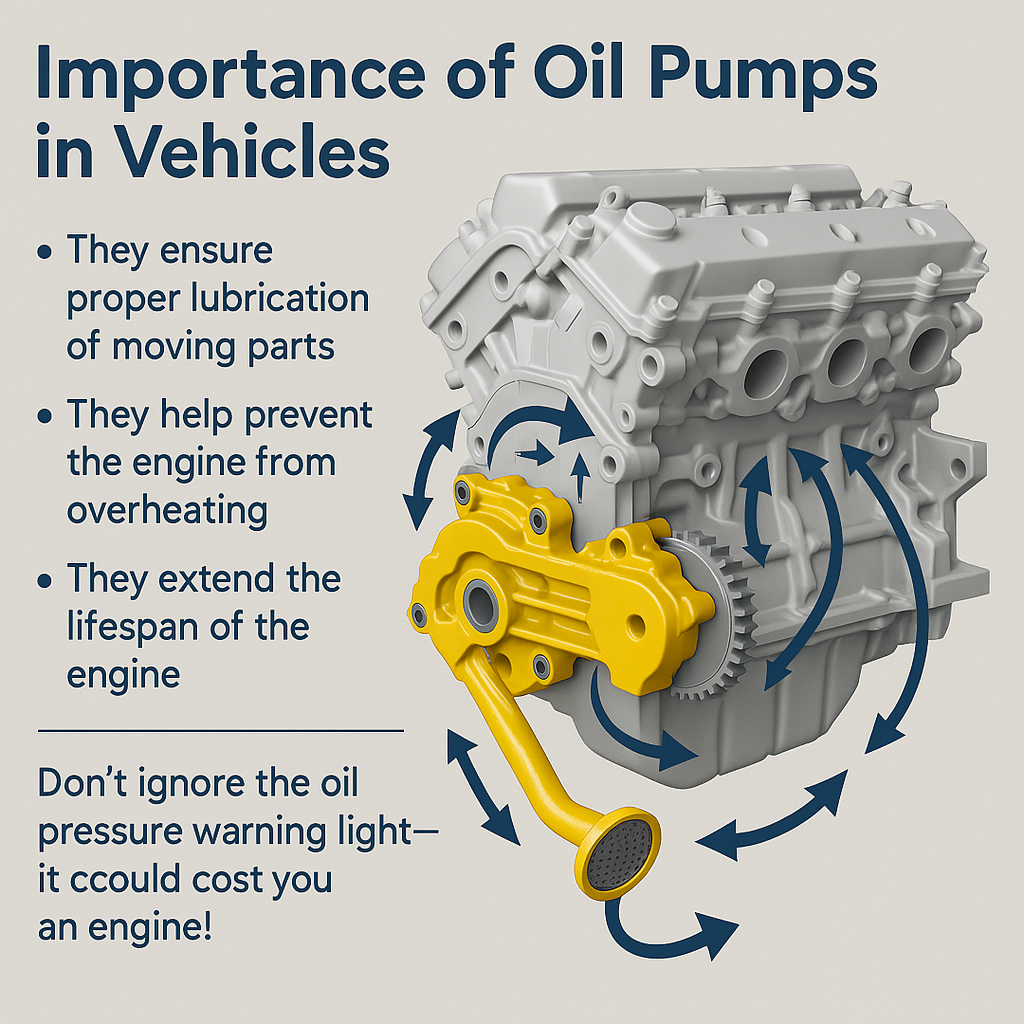
Oil pumps are super important for keeping your vehicle running smoothly. Here’s why:
- They make sure all the moving parts in your engine stay well-lubricated. Without proper lubrication, these parts would quickly wear out or even seize up.
- By circulating oil, they help prevent your engine from overheating. The oil carries heat away from hot spots, kind of like a liquid coolant.
- A good oil pump can significantly extend the life of your engine. It’s like eating healthy and exercising – it keeps everything in good shape for longer.
I once had a friend who ignored his oil pressure warning light. Long story short, he ended up needing a whole new engine. Don’t be like my friend – take care of your oil pump!
6. Symptoms of a Failing Oil Pump
How do you know if your oil pump is having issues? Here are some signs to watch out for:
- Low oil pressure warning light: If this light comes on, it’s time to pay attention.
- Engine overheating: Without proper oil circulation, your engine can get too hot.
- Unusual engine noise: If you hear a lot of clicking or tapping, especially when the engine is warm, it could be a sign of low oil pressure.
Ignoring these symptoms can lead to serious engine damage. In the worst case, your engine could seize up completely. Trust me, that’s not a repair bill you want to see!
7. Maintenance and Care Tips for Oil Pumps
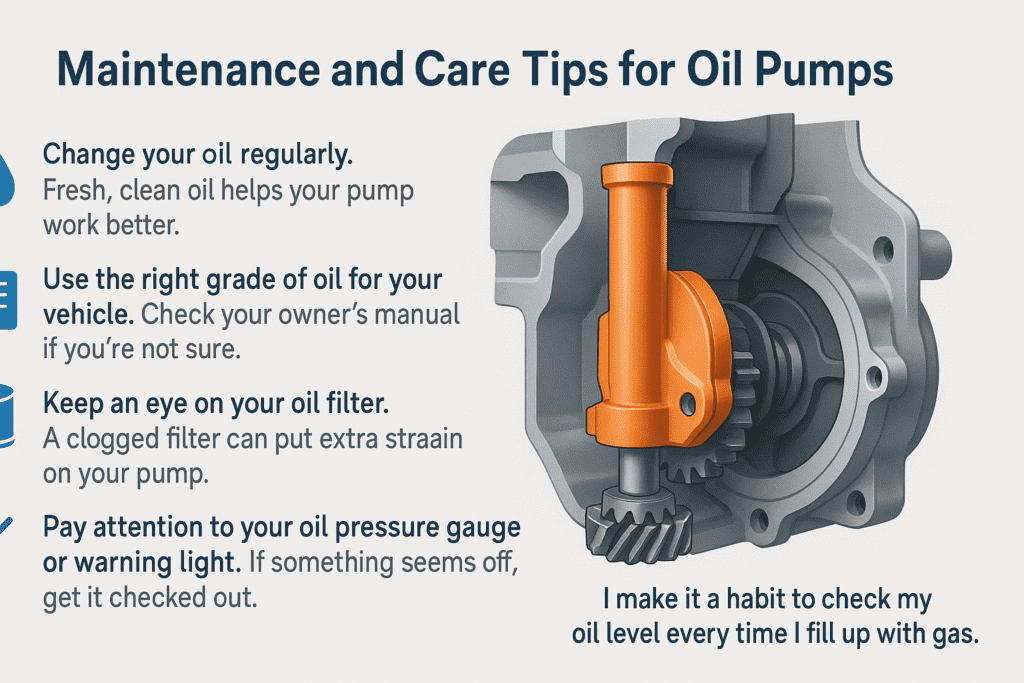
Taking care of your oil pump isn’t too complicated. Here are some tips:
- Change your oil regularly. Fresh, clean oil helps your pump work better.
- Use the right grade of oil for your vehicle. Check your owner’s manual if you’re not sure.
- Keep an eye on your oil filter. A clogged filter can put extra strain on your pump.
- Pay attention to your oil pressure gauge or warning light. If something seems off, get it checked out.
I make it a habit to check my oil level every time I fill up with gas. It only takes a minute, and it helps me catch any problems early.
8. Replacing an Oil Pump

If you need to replace your oil pump, here’s a basic overview of what’s involved:
- Drain the engine oil
- Remove the oil pan
- Locate and remove the old oil pump
- Install the new pump
- Replace the oil pan and refill with fresh oil
You’ll need some basic tools like wrenches, a jack, and jack stands. Unless you’re pretty handy with cars, this might be a job best left to the professionals. It can be tricky, and if not done right, could lead to serious engine problems.
I tried replacing my oil pump once. Let’s just say it took a lot longer than I expected, and I ended up with a few extra “mystery” bolts at the end!
9. Choosing the Right Oil Pump

When it’s time for a new oil pump, here’s what to consider:
- Make sure it’s compatible with your specific engine model.
- Look for pumps made from high-quality materials. Cheaper isn’t always better when it comes to engine parts.
- Stick with trusted brands and manufacturers. Your mechanic can probably recommend some good options.
Some well-regarded oil pump brands include Melling, Sealed Choosing the Right Oil Pump
When it’s time for a new oil pump, here’s what to consider:
- Make sure it’s compatible with your specific engine model.
- Look for pumps made from high-quality materials. Cheaper isn’t always better when it comes to engine parts.
- Stick with trusted brands and manufacturers. Your mechanic can probably recommend some good options.
To read more about firefighting click on this link: Firefighting
10. FAQs About Oil Pumps
Here are answers to some common questions about oil pumps:
How long does an oil pump last?
Most oil pumps are designed to last the lifetime of the engine, but they can fail earlier due to lack of maintenance or using the wrong type of oil.
Can a faulty oil pump damage the engine?
Absolutely. Without proper oil circulation, engine parts can wear out quickly or even seize up completely.
11. Conclusion
A well-functioning oil pump is crucial for keeping your engine running smoothly. By understanding how it works and what to look out for, you can help prevent major engine problems down the road.
Remember, if you’re ever in doubt about your oil pump or any other engine issue, it’s always best to consult a professional. Your engine (and wallet) will thank you in the long run!
Visit website to this link: Autobiography Zone
